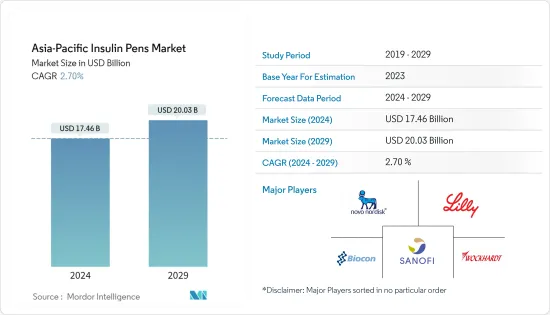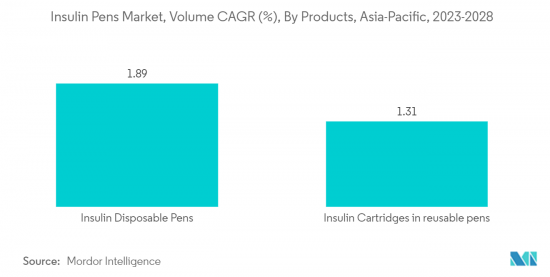PUBLISHER: Mordor Intelligence | PRODUCT CODE: 1408140

PUBLISHER: Mordor Intelligence | PRODUCT CODE: 1408140
Asia-Pacific Insulin Pens - Market Share Analysis, Industry Trends & Statistics, Growth Forecasts 2024 - 2029

The Asia-Pacific Insulin Pens Market size is estimated at USD 17.46 billion in 2024, and is expected to reach USD 20.03 billion by 2029, growing at a CAGR of 2.70% during the forecast period (2024-2029).
Patients with diabetes, infected with COVID-19 experienced elevated blood glucose, abnormal glucose variability, and diabetic complications. The prevalence of diabetes in people with COVID-19 caused a significant increase in the severity and mortality of COVID-19 in people with either type 1 or type 2 diabetes mellitus, especially in association with poor glycemic control. While new-onset hyperglycemia and new-onset diabetes were increasingly recognized in the context of COVID-19 and were associated with worse outcomes. To avoid aggravation, a patient's blood glucose had to be monitored and maintained. The pandemic emergency created a rise in remote care from both patients and providers and removed many long-standing regulatory barriers.
A disposable insulin pen is a prefilled pen and is thrown away after a single use whereas reusable pens permit the insertion of a pen fill (cartridge), allowing repeated usage. The needles on a reusable pen should be replaced periodically. Insulin Pens are the most widely used devices for the administration of insulin among diabetic patients. The ease of use and accuracy in administration make insulin pen usage convenient for insulin users. The main types of diabetes are type 1 diabetes and type 2 diabetes. For a patient with type 1 diabetes, insulin therapy is important for replacing the insulin that the body doesn't produce. People with type 2 diabetes or gestational diabetes need insulin therapy if other treatments such as diabetes medications and other lifestyle changes are not able to keep blood glucose levels within the desired range.
The Asia-Pacific region has witnessed an alarming increase in the prevalence of diabetes in recent years. In developing countries, such as China and India, the rate of diabetes is at an all-time high, mainly due to lifestyle changes. According to the International Diabetes Federation's latest estimates, 90 million adults were living with diabetes in the IDF South-East Asia Region. This figure is estimated to increase to 152 million by 2045 and 206 million adults were living with diabetes in the IDF Western Pacific Region which is estimated to increase to 260 million by 2045. Diabetes is associated with many health complications. Patients with diabetes require many corrections throughout the day to maintain nominal blood glucose levels, such as oral anti-diabetic medication, insulin administration, or ingestion of additional carbohydrates by monitoring their blood glucose levels.
Owing to the aforementioned factors the market is expected to grow over the forecast period.
Asia-Pacific Insulin Pens Market Trends
Insulin Cartridges in the reusable pens segment hold the highest market share in Asia-Pacific Insulin Pens Market in the current year
Insulin Cartridges in the reusable pens segment hold the highest market share in Asia-Pacific Insulin Pens Market in the current year and are expected to register a CAGR of about 2.49% over the forecast period.
Insulin pens are much smaller and more portable than syringes and have the medicine preloaded into the delivery mechanism. The needles are easy to use and can be disposed of by twisting or snapping. The pens are usually color-coded which makes it easier to know which type of insulin and how much insulin will be received from them. The insulin disposable pens are considered more consumer-friendly, as they are smaller and less noticeable than the classic vial-and-syringe. These devices are also more portable for consumers. Some pens are smart insulin pens that easily connect to an app on the phone to monitor blood sugar levels and remind the patients when to take the next insulin dose.
Insulin cartridges in reusable pens are an upgraded version of insulin vials. Most types of insulins are manufactured in the form of cartridges, making them easily accessible. These devices have all the functional benefits of reusable pens and are cost-effective, as these cartridges are less expensive compared to disposable insulin pens in the long run. Due to the increasing demand for insulin cartridges, most insulin device manufacturing companies have produced reusable insulin pens that are compatible with various insulin manufacturers' cartridges. Technological advancements have increased over the period in Insulin delivery devices for safer and more accurate administration of insulin.
Over the past few decades, Asian countries have witnessed a rapid increase in diabetes patients. Developing countries have more than 70% of the global diabetes population. The Asia-Pacific is anticipated to experience considerable growth due to a more geriatric population and rising prevalence of diabetes mainly due to the enhanced stress level, sedentary lifestyles, smoking, and excessive consumption of alcohol that elevates the body's sugar levels.
Owing to the rising rate of obesity, growing genetic factors for diabetes, the increasing prevalence, and the aforementioned factors the market will likely continue to grow.

Japan occupies the highest market share in the Asia-Pacific Insulin Pens Market in the current year
Japan occupies the highest market share in the Asia-Pacific Insulin Pens Market in the current year and is expected to grow at a CAGR of about 2.46% over the forecast period.
Diabetes reduces lifespan and people with the disease are likely to experience blindness and be hospitalized for amputations, kidney failure, heart attacks, strokes, and heart failure. Japan is a mature market, with some associated challenges, like slow economic growth, an aging population, and increased competition. Diabetes has been identified as a healthcare priority by the Ministry of Health, Labour, and Welfare. The high prevalence of diabetes is associated with a significant economic burden. The costs of diabetes are increased in patients with co-morbidities such as hypertension and hyperlipidemia and in patients who develop complications. Costs increase with an increasing number of complications.
Well-organized medical insurance systems cover all medical fees for diabetes mellitus, and diabetics can visit doctors freely in Japan. Also, insulin therapy by self-injection became legal and is covered by health insurance. The Japanese healthcare system has a few disease management programs conducted by the Japan Association for Diabetes Education and Care. Japan is one of the regional leaders in Asia-Pacific, in terms of diabetic public health policies. Such advantages have helped the rise in the adoption of these products in the Japanese market.
Owing to the aforementioned factors the market is expected to grow during the forecast period.
Asia-Pacific Insulin Pens Industry Overview
The Asia-Pacific insulin pens Market is moderately fragmented, with major manufacturers like Novo Nordisk, Sanofi, Eli Lilly, Biocon, Wockhardt, etc., having a global market presence and the remaining confined to the other local or region-specific manufacturers.
Additional Benefits:
- The market estimate (ME) sheet in Excel format
- 3 months of analyst support
TABLE OF CONTENTS
1 INTRODUCTION
- 1.1 Study Assumptions and Market Definition
- 1.2 Scope of the Study
2 RESEARCH METHODOLOGY
3 EXECUTIVE SUMMARY
4 MARKET DYNAMICS
- 4.1 Market Overview
- 4.2 Market Drivers
- 4.3 Market Restraints
- 4.4 Porter's Five Forces Analysis
- 4.4.1 Bargaining Power of Suppliers
- 4.4.2 Bargaining Power of Consumers
- 4.4.3 Threat of New Entrants
- 4.4.4 Threat of Substitute Products and Services
- 4.4.5 Intensity of Competitive Rivalry
5 MARKET SEGMENTATION
- 5.1 Product
- 5.1.1 Disposable Insulin Pens
- 5.1.2 Cartridges in Reusable Pens
- 5.2 Geography
- 5.2.1 Japan
- 5.2.2 South Korea
- 5.2.3 China
- 5.2.4 India
- 5.2.5 Australia
- 5.2.6 Vietnam
- 5.2.7 Malaysia
- 5.2.8 Indonesia
- 5.2.9 Philippines
- 5.2.10 Thailand
- 5.2.11 Rest of Asia-Pacific
6 MARKET INDICATORS
- 6.1 Type-1 Diabetes Population
- 6.2 Type-2 Diabetes Population
7 COMPETITIVE LANDSCAPE
- 7.1 COMPANY PROFILES
- 7.1.1 Novo Nordisk
- 7.1.2 Sanofi
- 7.1.3 Eli Lilly
- 7.1.4 Biocon
- 7.1.5 Wockhardt
- 7.1.6 Julphar
- 7.1.7 Terumo
- 7.1.8 Gan and Lee
- 7.2 COMPANY SHARE ANALYSIS
- 7.2.1 Novo Nordisk
- 7.2.2 Sanofi
- 7.2.3 Eli Lilly
- 7.2.4 Other Company Share Analyses
8 MARKET OPPORTUNITIES AND FUTURE TRENDS




